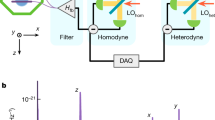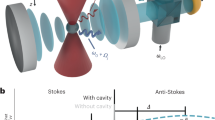Abstract
Controlling the motional degrees of isolated, single nanoparticles trapped within optical fields in a high vacuum are seen as ideal candidates for exploring the limits of quantum mechanics in a new mass regime. These systems are also massive enough to be considered for future laboratory tests of the quantum nature of gravity. Recently, the translational motion of trapped particles has been cooled to microkelvin temperatures, but controlling all the observable degrees of freedom, including their orientational motion, remains an important goal. Here we report the control and cooling of all the translational and rotational degrees of freedom of a nanoparticle trapped in an optical tweezer, accomplished by cavity cooling via coherent elliptic scattering. We reached temperatures in the range of hundreds of microkelvins for the translational modes and temperatures as low as 5 mK for the librational degrees of freedom. This work brings within reach applications in quantum science and the study of single isolated nanoparticles via imaging and diffractive methods, free of interference from a substrate.
This is a preview of subscription content, access via your institution
Access options
Access Nature and 54 other Nature Portfolio journals
Get Nature+, our best-value online-access subscription
$29.99 / 30 days
cancel any time
Subscribe to this journal
Receive 12 print issues and online access
$209.00 per year
only $17.42 per issue
Buy this article
- Purchase on Springer Link
- Instant access to full article PDF
Prices may be subject to local taxes which are calculated during checkout




Similar content being viewed by others
Data availability
Source data are provided with this paper. All other data that support the plots within this paper and other findings of this study are available from the corresponding authors upon reasonable request.
References
Seis, Y. et al. Ground state cooling of an ultracoherent electromechanical system. Nat. Commun. 13, 1507 (2022).
Ockeloen-Korppi, C. et al. Stabilized entanglement of massive mechanical oscillators. Nature 556, 478–482 (2018).
Gavartin, E., Verlot, P. & Kippenberg, T. J. A hybrid on-chip optomechanical transducer for ultrasensitive force measurements. Nat. Nanotechnol. 7, 509–514 (2012).
Higginbotham, A. et al. Harnessing electro-optic correlations in an efficient mechanical converter. Nat. Phys. 14, 1038–1042 (2018).
Middlemiss, R. et al. Measurement of the Earth tides with a MEMS gravimeter. Nature 531, 614–617 (2016).
Magrini, L. et al. Real-time optimal quantum control of mechanical motion at room temperature. Nature 595, 373–377 (2021).
Kamba, M., Shimizu, R. & Aikawa, K. Optical cold damping of neutral nanoparticles near the ground state in an optical lattice. Opt. Express 30, 26716–26727 (2022).
Tebbenjohanns, F. et al. Quantum control of a nanoparticle optically levitated in cryogenic free space. Nature 595, 378–382 (2021).
Delić, U. et al. Cooling of a levitated nanoparticle to the motional quantum ground state. Science 367, 892–895 (2020).
Ranfagni, A. et al. Two-dimensional quantum motion of a levitated nanosphere. Phys. Rev. Research 4, 033051 (2022).
Piotrowski, J. et al. Simultaneous ground-state cooling of two mechanical modes of a levitated nanoparticle. Nat. Phys. https://doi.org/10.1038/s41567-023-01956-1 (2023).
Windey, D. et al. Cavity-based 3D cooling of a levitated nanoparticle via coherent scattering. Phys. Rev. Lett. 122, 123601 (2019).
Delić, U. et al. Cavity cooling of a levitated nanosphere by coherent scattering. Phys. Rev. Lett. 122, 123602 (2019).
Toroš, M. & Monteiro, T. S. Quantum sensing and cooling in three-dimensional levitated cavity optomechanics. Phys. Rev. Research 2, 023228 (2020).
Toroš, M. et al. Coherent-scattering two-dimensional cooling in levitated cavity optomechanics. Phys. Rev. Research 3, 023071 (2021).
Vuletić, V. & Chu, S. Laser cooling of atoms, ions, or molecules by coherent scattering. Phys. Rev. Lett. 84, 3787 (2000).
Kuhn, S. et al. Full rotational control of levitated silicon nanorods. Optica 4, 356–360 (2017).
Stickler, B. A. et al. Probing macroscopic quantum superpositions with nanorotors. New J. Phys. 20, 122001 (2018).
Ma, Y. et al. Quantum persistent tennis racket dynamics of nanorotors. Phys. Rev. Lett. 125, 053604 (2020).
Rashid, M. et al. Precession motion in levitated optomechanics. Phys. Rev. Lett. 121, 253601 (2018).
Ahn, J. et al. Optically levitated nanodumbbell torsion balance and GHz nanomechanical rotor. Phys. Rev. Lett. 121, 033603 (2018).
van der Laan, F. et al. Optically levitated rotor at its thermal limit of frequency stability. Phys. Rev. A 102, 013505 (2020).
Miao, J. et al. Extending the methodology of X-ray crystallography to allow imaging of micrometre-sized non-crystalline specimens. Nature 400, 342–344 (1999).
Gao, Y. et al. Three-dimensional optical trapping and orientation of microparticles for coherent X-ray diffraction imaging. Proc. Natl Acad. Sci. USA 116, 4018–4024 (2019).
van der Laan, F. et al. Sub-kelvin feedback cooling and heating dynamics of an optically levitated librator. Phys. Rev. Lett. 127, 123605 (2021).
Bang, J. et al. Five-dimensional cooling and nonlinear dynamics of an optically levitated nanodumbbell. Phys. Rev. Research 2, 043054 (2020).
Schäfer, J. et al. Cooling nanorotors by elliptic coherent scattering. Phys. Rev. Lett. 126, 163603 (2021).
Rudolph, H. et al. Theory of nanoparticle cooling by elliptic coherent scattering. Phys. Rev. A 103, 043514 (2021).
Sihvola, A. Dielectric polarization and particle shape effects. J. Nanomater. 2007, 1 (2007).
Bullier, N. P., Pontin, A. & Barker, P. F. Quadratic optomechanical cooling of a cavity-levitated nanosphere. Phys. Rev. Research 3, L032022 (2021).
Cavalleri, A. et al. Gas damping force noise on a macroscopic test body in an infinite gas reservoir. Phys. Lett. A 374, 3365–3369 (2010).
Pontin, A. et al. Ultranarrow-linewidth levitated nano-oscillator for testing dissipative wave-function collapse. Phys. Rev. Research 2, 023349 (2020).
Zheng, D. et al. Room temperature test of the continuous spontaneous localization model using a levitated micro-oscillator. Phys. Rev. Research 2, 013057 (2020).
Millen, J. et al. Nanoscale temperature measurements using non-equilibrium Brownian dynamics of a levitated nanosphere. Nat. Nanotechnol. 9, 425–429 (2014).
Papendell, B., Stickler, B. A. & Hornberger, K. Quantum angular momentum diffusion of rigid bodies. New J. Phys. 19, 122001 (2017).
Stickler, B. A., Schrinski, B. & Hornberger, K. Rotational friction and diffusion of quantum rotors. Phys. Rev. Lett. 121, 040401 (2018).
Toroš, M., Rashid, M. & Ulbricht, H. Detection of anisotropic particles in levitated optomechanics. Phys. Rev. A 98, 053803 (2018).
Millen, J. et al. Cavity cooling a single charged levitated nanosphere. Phys. Rev. Lett. 114, 123602 (2015).
Fonseca, P. Z. G. et al. Nonlinear dynamics and strong cavity cooling of levitated nanoparticles. Phys. Rev. Lett. 117, 173602 (2016).
Kiesel, N. et al. Cavity cooling of an optically levitated submicron particle. Proc. Natl Acad. Sci. USA 110, 14180–14185 (2013).
Seberson, T. & Robicheaux, F. Parametric feedback cooling of rigid body nanodumbbells in levitated optomechanics. Phys. Rev. A 99, 013821 (2019).
Abdi, M. et al. Effect of phase noise on the generation of stationary entanglement in cavity optomechanics. Phys. Rev. A 84, 032325 (2011).
Rabl, P. et al. Phase-noise induced limitations on cooling and coherent evolution in optomechanical systems. Phys. Rev. A 80, 063819 (2009).
Risken, H. The Fokker-Planck Equation (Springer, 1989).
Douglas, P., Bergamini, S. & Renzoni, F. Tunable Tsallis distributions in dissipative optical lattices. Phys. Rev. Lett. 96, 110601 (2006).
Lutz, E. Anomalous diffusion and Tsallis statistics in an optical lattice. Phys. Rev. A 67, 051402 (2003).
Bose, S. et al. Spin entanglement witness for quantum gravity. Phys. Rev. Lett. 119, 240401 (2017).
Weiss, T. et al. Large quantum delocalization of a levitated nanoparticle using optimal control: applications for force sensing and entangling via weak forces. Phys. Rev. Lett. 127, 023601 (2021).
Gittes, F. & Schmidt, C. F. Interference model for back-focal-plane displacement detection in optical tweezers. Opt. Lett. 23, 7–9 (1998).
Gieseler, J. et al. Subkelvin parametric feedback cooling of a laser-trapped nanoparticle. Phys. Rev. Lett. 109, 103603 (2012).
Seberson, T. A. Heating and Cooling Mechanisms for the Thermal Motion of an Optically Levitated Nanoparticle. PhD thesis, Purdue Univ. Graduate School (2020).
Jackson, J. D. Classical Electrodynamics (Wiley, 1999).
Novotny, L. & Hecht, B. Principles of Nano-Optics (Cambridge Univ. Press, 2012).
Acknowledgements
A.P. thanks F. Marin for useful discussions. We acknowledge funding from EPSRC grant no. EP/N031105/1 and EP/S000267/1 . H.F. acknowledges the Engineering and Physical Sciences Research Council (grant no. EP/L015242/1). M.T. acknowledges funding by the Leverhulme Trust (RPG-2020-197).
Author information
Authors and Affiliations
Contributions
A.P. and P.F.B. conceived and designed the experiment. A.P. and H.F. performed the experiment. A.P. performed the data analysis. A.P., M.T. and T.S.M. carried out the theoretical calculations including the stochastic numerical simulations. All the authors have engaged at every step and provided valuable input. A.P. and P.F.B. wrote the paper with important contributions from all the authors. P.F.B. coordinated the project.
Corresponding authors
Ethics declarations
Competing interests
The authors declare no competing interests.
Peer review
Peer review information
Nature Physics thanks the anonymous reviewers for their contribution to the peer review of this work.
Additional information
Publisher’s note Springer Nature remains neutral with regard to jurisdictional claims in published maps and institutional affiliations.
Extended data
Extended Data Fig. 1 Comparison between measured effective temperatures and model estimates as a function of pressure.
Theoretical curves (solid lines) assume nominal parameters without any fitting. Also shown are bands (shaded regions) which reflect how the model is affected by experimental uncertainties. The CoM x, y and z are shown in panels a), b) and c) respectively. The angular DoFs α, β and γ in panels d), e) and f) respectively. The gray dashed line in all panel marks the room temperature. Data are presented as mean values ± SD on a sample size of 10 elements. Error bars for the pressure values reflect the accuracy of the gauge.
Supplementary information
Supplementary Information
Supplementary Sections I–VI, Figs. 1–8 and Tables I and II.
Source data
Source Data Fig. 2
Data for Fig. 2a–e.
Source Data Extended Data Fig. 1
Data for Extended Data Fig. 1.
Rights and permissions
Springer Nature or its licensor (e.g. a society or other partner) holds exclusive rights to this article under a publishing agreement with the author(s) or other rightsholder(s); author self-archiving of the accepted manuscript version of this article is solely governed by the terms of such publishing agreement and applicable law.
About this article
Cite this article
Pontin, A., Fu, H., Toroš, M. et al. Simultaneous cavity cooling of all six degrees of freedom of a levitated nanoparticle. Nat. Phys. 19, 1003–1008 (2023). https://doi.org/10.1038/s41567-023-02006-6
Received:
Accepted:
Published:
Issue Date:
DOI: https://doi.org/10.1038/s41567-023-02006-6
This article is cited by
-
Cavity-mediated long-range interactions in levitated optomechanics
Nature Physics (2024)
-
Ground-state cooling goes 2D
Nature Physics (2023)
-
Nanoscale feedback control of six degrees of freedom of a near-sphere
Nature Communications (2023)



